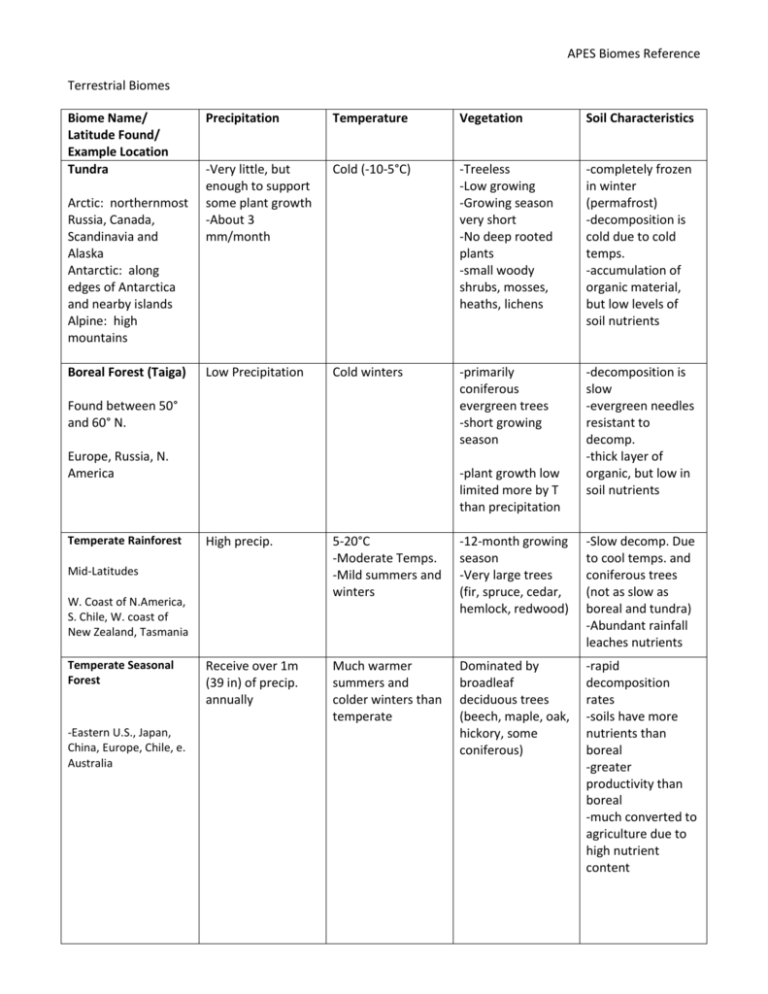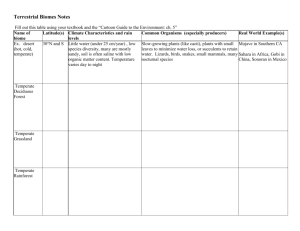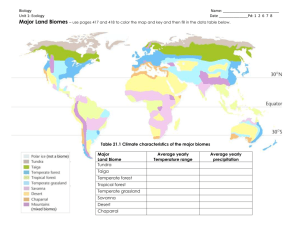APES Biomes Reference Terrestrial Biomes Biome Name/ Latitude
advertisement

APES Biomes Reference Terrestrial Biomes Biome Name/ Latitude Found/ Example Location Tundra Arctic: northernmost Russia, Canada, Scandinavia and Alaska Antarctic: along edges of Antarctica and nearby islands Alpine: high mountains Boreal Forest (Taiga) Precipitation Temperature Vegetation Soil Characteristics -Very little, but enough to support some plant growth -About 3 mm/month Cold (-10-5°C) -Treeless -Low growing -Growing season very short -No deep rooted plants -small woody shrubs, mosses, heaths, lichens -completely frozen in winter (permafrost) -decomposition is cold due to cold temps. -accumulation of organic material, but low levels of soil nutrients Low Precipitation Cold winters -primarily coniferous evergreen trees -short growing season -decomposition is slow -evergreen needles resistant to decomp. -thick layer of organic, but low in soil nutrients Found between 50° and 60° N. Europe, Russia, N. America Temperate Rainforest -plant growth low limited more by T than precipitation High precip. 5-20°C -Moderate Temps. -Mild summers and winters -12-month growing season -Very large trees (fir, spruce, cedar, hemlock, redwood) -Slow decomp. Due to cool temps. and coniferous trees (not as slow as boreal and tundra) -Abundant rainfall leaches nutrients Receive over 1m (39 in) of precip. annually Much warmer summers and colder winters than temperate Dominated by broadleaf deciduous trees (beech, maple, oak, hickory, some coniferous) -rapid decomposition rates -soils have more nutrients than boreal -greater productivity than boreal -much converted to agriculture due to high nutrient content Mid-Latitudes W. Coast of N.America, S. Chile, W. coast of New Zealand, Tasmania Temperate Seasonal Forest -Eastern U.S., Japan, China, Europe, Chile, e. Australia Woodland/Shrubland Rainy winters Hot, dry summers 12-month growing season, but plants growth constrained by low precip. in summer and low winter temp. -plants well adapted to both fire and drought Lowest avg. precip. of any temperate biome Cold, harsh winders Hot, dry summers Wet with seasonal pattern that depend on when ITCZ passes overhead Average T exceeds 20°C with little seasonal T variation Distinct wet and dry seasons caused by seasonal movement of ITCZ -drops precipitation only during summer Warm T -plant growth constrained by insufficient precip. in summer and cold temps. In winter -fires are common (dry and windy) -grasses, nonwoody flowering plants Productivity is high -nutrients are taken up quickly by vegetation -more biodiversity per hectare than only other terrestrial biome -large trees with layers of shorter trees (canopy, understory), woody vines -trees drop leaves during the dry season and produce new leaves during wet season (deciduous) -form savannas Extremely dry conditions Hot T Found of coast of southern CA (chaparral) and in so. South America, SW Australia, southern Africa and around Mediterranean Sea Temperate Grassland/Cold Desert Great Plains of N. America (prairies) S. America c. Asia and eastern Europe Tropical Rainforest 20°N and 20° S of the equator Central and South America, Africa, SE Asia, and NE Australia, large tropical islands Tropical Seasonal Forest/Savanna Common in much of Central America and on Atlantic coast of S. America and S. Asia, NW Australia, subSaharan Africa Subtropical Desert 30°N and 30°S Sparse vegetation Special adaptations -favor natural occurrence of wildfires -soils low in nutrients because of leaching by winter rains -biggest use is grazing animals and drought-tolerant deep-rooted crops such as grapes -long growing season and rapid decomposition add large amount of nutrients to soil (so grasslands very productive) -98% in U.S. converted to ag. Decomp. Is extremely rapid -not much nutrient is soil because is in vegetation -much is cleared for agricultural (doesn’t keep nutrients long -warm T promote decomposition, but low precip. constrain plants from using the soil nutrients that are released -fairly fertile, can be farmed Aquatic Biomes Biome Name/ Example Location Streams and Rivers Salinity Depth Water Flow none -streams relatively narrow and carry small amounts of water -rivers typically wider and carry larger amounts Lakes and Ponds None -lakes are larger than ponds Flowing fresh water that may originate from underground springs or as runoff -rivers can contain rapids -faster moving/more oxygen -Contain standing water, at least some of which is too deep to support emergent vegetation Freshwater Wetlands Aquatic biomes that are submerged or saturated by water for at least part of the year. Salt Marshes Salt water mixed with fresh water Found along the coast in temperate climates Contain non-woody emergent vegetation Mangrove Swamps Occur along tropical and subtropical coasts Contain trees whose roots are submerged in water Submerged or saturated by water for at least part of each year, but shallow enough to support emergent vegetation One of most productive biomes in the world Many found is estuaries Salt tolerant vegetation Common Characteristic -few plants or algae to act as producers -organic matter comes from fallen leaves, etc. Several distinct zones -phytoplankton are only photosynthetic organisms -bacteria decompose detritus that reaches the profundal zone (consume much oxygen) Swamps Marshes Boggs Extremely productive because rivers carry large amounts of nutrient-rich organic material Provide important habitat for spawning fish and shellfish Provide habitat for fish and shellfish Falling leaves and trapped organic material produce a nutrient-rich environment Intertidal Zone Narrow band of coastline that exists between the levels of high tide and low tide Range from steep rocky areas to broad, sloping mudflats Coral Reefs Can only live in shallow waters where light penetrates Warm, shallow waters beyond the shoreline Open Ocean yes Deep water ocean Live in water that is poor in nutrients and food







